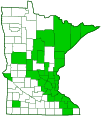Aborted Entoloma
(Entoloma abortivum)
Conservation • Description • Habitat • Ecology • Distribution • Taxonomy
|
|
||||||||||||||
Description |
Aborted Entoloma is both a typical mushroom and an infection of other mushrooms. As a typical mushroom, it obtains nutrients from non-living organic matter (saprobic), specifically woody debris and leaf litter. As an infection, it grows with and obtains nutrients from (parasitizes) Honey Mushroom (Armillaria mellea group). When a Honey Mushroom is infected, it forms a lumpy mass called a carpophoroid. Aborted Entoloma is common and widespread in eastern North America in hardwood forests. It is found from mid-September through October on the ground, scattered or in groups, near decaying wood or in leaf litter. It is most often found with or near Honey Mushrooms. It is easily identified in its aborted (carpophoroid) form, and nearly impossible to identify in its mushroom form. Mushroom The stalk is ¾″ to 3″ long and 3 ⁄16″to ⅝″ thick. It is solid, hairless or finely hairy, and sometimes somewhat enlarged at the base. The base of the stalk is covered with a white fuzz that is part of the underground, vegetative component (mycelium). The flesh is white and dense. It is edible but difficult to distinguish from other poisonous Entolomas. For this reason, only the aborted carpophoroid version should be eaten. The gills are pale gray at first, becoming pink due to a covering of spores. They are close and slightly run down the stalk. The spore print is pink. Carpophoroid A carpophoroid is the above-ground structure of a fungus whose development suggests a fruiting body but stops before developing a normal mushroom shape and does not become reproductive. When this fungus was first described, it was thought that the lumpy mass was a Entoloma abortivum (then called Clitopilus abortivus) mushroom that never developed properly. Studies by Roy Walting in 1974 showed it to be a fungus parasitized by another fungus. He concluded that the aborted fruiting body was an E. abortivum mushroom parasitized by a Honey Mushroom (Armillaria mellea group). In 2001, research published in Mycologia (Czederpiltz, Daniel Linder, Thomas J. Volk, and Harold H. Burdsall, Jr. 2001) suggested that the carpophoroid is in reality a Honey Mushroom parasitized by the E. abortivum fungus. This conclusion remains controversial because Honey Mushroom is only found growing on wood and Aborted Entoloma is only found growing on the ground. If true, Volk suggests that the common name is incorrect and should be changed to Aborted Armillaria. |
Similar Species |
Habitat and Hosts |
Hardwood forests |
Ecology |
Season |
Mid-September through October |
Distribution |
||
|
Sources |
|
| 6/13/2024 | ||
Occurrence |
||
Common and widespread in eastern North America |
||
Taxonomy |
|
| Kingdom | Fungi (Fungi) |
| Subkingdom | Dikarya |
| Phylum | Basidiomycota (Basidiomycete Fungi) |
| Subphylum | Agaricomycotina (Higher Basidiomycetes) |
| Class | Agaricomycetes (Mushrooms, Bracket Fungi, Puffballs, and Allies) |
| Subclass | Agaricomycetidae |
| Order | Agaricales (Common Gilled Mushrooms and Allies) |
| Suborder | Tricholomatineae |
| Family | Entolomataceae |
| Genus | Entoloma (pinkgills) |
| Subgenus | Claudopus |
Subordinate Taxa |
|
|
|
Synonyms |
|
Agaricus abortivus Clitopilus abortivus Pleuropus abortivus Rhodophyllus abortivus |
|
Common Names |
|
Aborted Entoloma shrimp of the woods |
|
Glossary
Carpophoroid
The above-ground structure of a fungus whose development suggests a fruiting body but stops before developing a normal mushroom shape and does not become reproductive.
Parasitic
Obtaining nutrients from another living organism.
Saprobic
A term often used for saprotrophic fungi. Referring to fungi that obtain their nutrients from decayed organic matter.
Visitor Photos |
||
Share your photo of this fungus. |
||
This button not working for you? |
||
Kathryn Wallis |
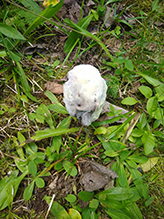 |
Found on the SHT near Two Harbors. |
Deb Wech |
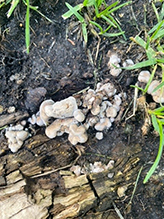 |
Scott Fluegel |
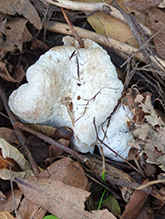 |
Honey Fae (Farah) |
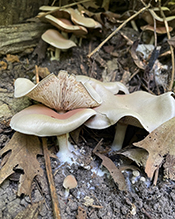 |
Stephanie Segner |
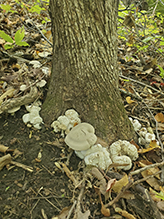 |
dg99 |
||
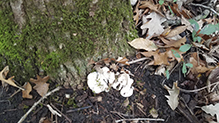 |
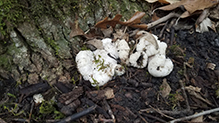 |
|
Kirk Nelson |
||
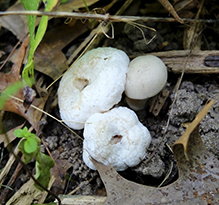 |
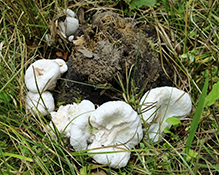 |
|
MinnesotaSeasons.com Photos |
||

Slideshows |
|

Visitor Videos |
||
Share your video of this fungus. |
||
This button not working for you? |
||
|
Other Videos |
||
Aborted Entoloma Mushroom |
About
Published on Sep 27, 2011 Thanks for watching MiWilderness. |
Aborted Entoloma |
About
Published on Nov 16, 2007 Video of Aborted entoloma mushrooms |
Found some Abortive Entoloma, Entoloma abortivum today! |
About
Published on Oct 18, 2016 The controversy, does abortive entoloma parasite honey mushrooms (Armillaria mellea) or is it the other way around? Or something completely different. https://www.youtube.com/redirect?redir_token=QuONatMdIp4Of9RSs-c8IFzsROp8MTUwNjUyOTExOEAxNTA2NDQyNzE4&event=video_description&q=http%3A%2F%2Fwww.mushroomexpert.com%2Fentoloma_abortivum.html In my limited experience it seems to me that honey mushrooms would not be growing in the locations where I found these entoloma. Notice the first set around a healthy young tree. I have yet to find any honeys growing off of healthy trees, especially young. The second set growing off the dead rootball of the tree seems an unlikely location for honey mushrooms to grow either, growing from the muddy side. I did not see any honey mushrooms in the immediate area of both groups (doesn't mean they were not there though). I do see honey's growing in small amounts all through the forest. I did not see any entolomas around the large honey mushroom grow site of my previous video (and most of those honeys were breaking down now). I am thinking about experimenting next year and spraying entoloma liquid culture/spores in that large honey mushroom area to see if I can force the parasitification. The Lobster mushrooms: https://www.youtube.com/redirect?redir_token=QuONatMdIp4Of9RSs-c8IFzsROp8MTUwNjUyOTExOEAxNTA2NDQyNzE4&event=video_description&q=http%3A%2F%2Fwww.mushroomexpert.com%2Fhypomyces_lactifluorum.html |
Abortive Entoloma (snow shrimp) |
About
Published on Oct 7, 2013 |

Visitor Sightings |
||
Report a sighting of this fungus. |
||
This button not working for you? |
||
| Scott Fluegel 9/26/2023 |
Location: Nerstrand Big Woods State Park |
| Honey Fae (Farah) 8/26/2022 |
Location: Dakota County, MN |
| dg99 10/3/2021 |
Location: Washington County, MN |
| Stephanie Segner 9/24/2021 |
Location: Long Lake, MN |
Kathryn Wallis |
Location: Superior Hiking Trail Found on the SHT near Two Harbors. |
| Kirk Nelson 9/10/2017 |
Location: Lebanon Hills Regional Park |
MinnesotaSeasons.com Sightings |
||

Created: 9/26/2017 Last Updated: © MinnesotaSeasons.com. All rights reserved. |
